Exploring Contemporary Wood Bath Vanities for Style
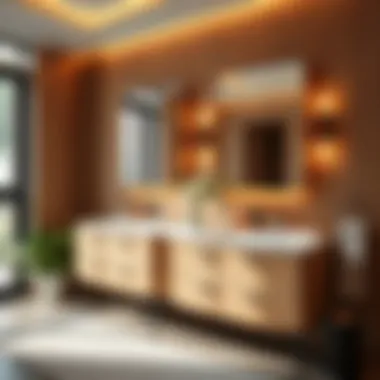
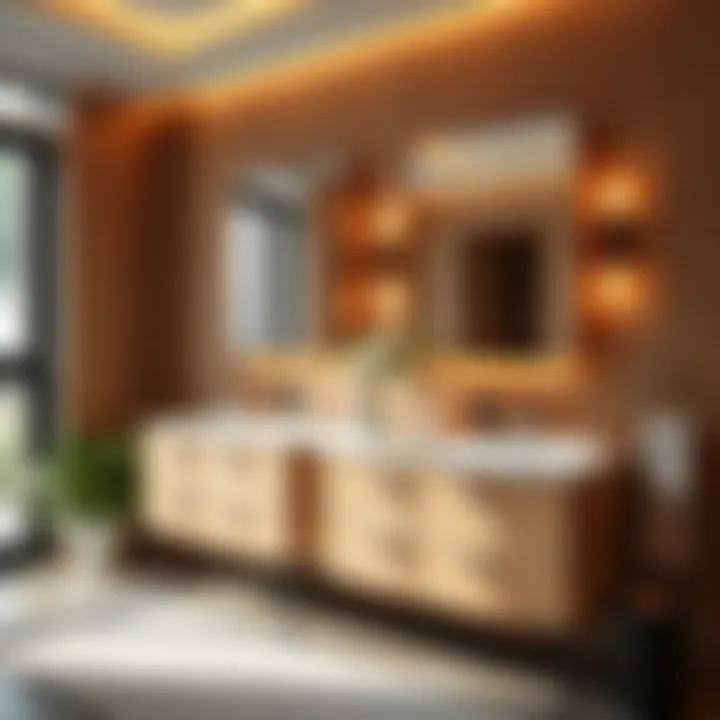
Intro
As we step into the realm of contemporary home design, one feature that has caught the eye of designers and homeowners alike is the modern wood bath vanity. These vanities bring a harmonious blend of aesthetics, durability, and functionality to what is often a neglected space in many homes. Whether you're embarking on a bathroom renovation or merely seeking a way to refresh your daily routine, understanding the various design perspectives can significantly impact your choices.
This guide aims to spotlight the intricacies associated with modern wood bath vanities—from the key designs that are taking center stage to practical advice on color palettes and maintenance. We will dive into trending styles, the best materials, and elements that align with sustainable practices, ensuring that each decision enhances your bathroom's overall vibe. All in all, it’s about creating a space that mirrors not just modern taste but also personal style.
By the end of this exploration, you will be equipped to select the perfect vanity that not only complements your bathroom but also aligns with your desires for function and design. With each section, we’ll peel back the layers on this intriguing topic—a step-by-step journey designed for those who appreciate the beauty of quality and craftsmanship.
Understanding Modern Wood Bath Vanities
Wood bath vanities are more than just functional pieces of furniture in modern bathrooms; they serve as pivotal design elements that can define a space. When one considers a wood vanity, it’s essential to understand both its aesthetic and practical importance, particularly in today’s designs that emphasize personal style and sustainability. The bathroom is often seen as a sanctuary, a space for relaxation and rejuvenation. A well-crafted wooden vanity can enhance that atmosphere, providing character while also being functional.
Defining Modern Design
Modern design tends to favor clean lines, simplicity, and functionality, which can harmoniously complement the organic textures of wood. Think about a bright, airy space where the stunning grain of mahogany or walnut can shine through without clutter. Wood vanities embrace this aesthetic by showcasing their natural beauty while meeting contemporary needs.
For instance, a floating wooden vanity can give the illusion of a larger bathroom, making it feel less cramped. The subtle warmth of wood pairs excellently with a minimalist decor approach, where less is often more. The challenge often lies in ensuring that modern aesthetics do not overshadow the natural characteristics of the wood. This means striking a balance between style and functionality, with design choices that enhance the inherent qualities of wood without overwhelming them.
Material Characteristics
The types of wood used in these vanities vary widely, including oak, maple, cherry, and bamboo. Each material comes with its unique attributes, affecting both durability and appearance. Oak, for instance, is known for its robustness and intricate patterns, while bamboo is celebrated for its sustainable qualities.
Also crucial to consider is the finishing process. A well-treated wooden vanity can resist moisture—an essential aspect in a bathroom setting. Look for finishes that provide protection against water damage and staining while enhancing the depth of color in the wood. An assortment of finishes—ranging from matte to glossy—can also allow homeowners to customize their look, whether they want rustic charm or sleek modernity.
Historical Context
Wood has long been a staple in furniture design, with origins tracing back centuries. Historically, vanities were staunchly utilitarian, often made of heavy wood and adorned with ornate carvings as symbols of wealth and status. Today, the modern interpretation allows for a more refined, streamlined approach while respecting the craftsmanship of the past.
As society progressed, so did the aesthetic preferences. The shift from overly embellished designs to simpler forms came hand-in-hand with the rise of minimalism in the late 20th century. This contextual shift laid the groundwork for modern wood bath vanities, which encapsulate both historical richness and contemporary simplicity.
Understanding modern wood bath vanities thus involves grasping the integration of these various factors—design, material, and history. It paints a compelling picture, one that resonates well with both homeowners and designers seeking that perfect balance of functionality and elegance.
The Aesthetics of Wood in Bathroom Design
The charm of wood in bathroom design lies significantly in its ability to blend warmth with sophistication. The use of wood not only enhances the visual appeal of a space but also fosters a sense of tranquility, making it a favored choice in today's modern homes. As homeowners seek to establish a sanctuary within their bathrooms, understanding the aesthetics of wood becomes essential in selecting the perfect vanity that resonates with both style and ambiance.
Natural Beauty of Wood
Wood possesses an innate charm that manufactured materials often can’t replicate. Each piece tells a story; from the grain patterns to the rich tones, it reflects nature’s beauty. This uniqueness not only draws the eye but also invites touch. Imagine brushing your hand across a beautifully finished oak surface, feeling its warmth and texture. It’s these sensory experiences that create a distinct atmosphere in a bathroom setting.
Moreover, the use of reclaimed wood can add even more character. It reflects sustainability and a narrative of sustainability, giving old materials new life with each installation. The natural imperfections and variations signal authenticity and craftsmanship, qualities that resonate deeply with homeowners who value individuality.
Color and Finish Options
When it comes to color and finish, wood offers a spectrum that caters to any aesthetic preference. From deep mahogany to lighter ash, the choices are as diverse as they are striking.
- Natural Stains: Allowing the wood's inherent color to shine through while accentuating the grain family, natural stains help maintain a rustic feel, perfect for contemporary and farmhouse styles alike.
- Painted Finishes: Creams, grays, and pastels can transition the same piece into a sleeker, more modern vibe. A painted wood vanity, for instance, can add vibrancy or softness depending on the palette chosen.
- Glossy vs. Matte: The finish can alter the character as well. A high gloss might suggest modernity, while a matte finish opens up a more organic feel.
These variances in finishing options allow homeowners to embody their vision, establishing a mood that aligns with their personal tastes while still maintaining the functional aspect of the space.
Complementary Design Elements
To maximize the beauty of wood bath vanities, it is essential to consider complementary design elements. Integrating wood requires a cohesive approach, where other materials and colors work in harmony.
- Metals: Brass or copper fixtures can elevate wood's natural warmth when strategically placed. For instance, mottled brass handles can make a rustic wood vanity stand out, adding a touch of elegance.
- Stone: Pairing wood with marble or granite countertops fosters a luxurious juxtaposition. The coolness of stone offsets the warmth of wood, resulting in a balanced aesthetic.
- Textiles: Elements like plush towels or woven baskets can subtly complement wood while enhancing the cozy vibe of the space. Darker woods might look splendid with cream or beige, while lighter woods can pop against bold colors.
In a nutshell, wood bath vanities serve as not just functional fixtures but also as central pieces that can dictate the overall design narrative of the space.
By thoughtfully incorporating wood into bathroom design, homeowners can create an oasis that speaks to their values, style, and the essence of home.
Functional Aspects of Wood Bath Vanities
When it comes to modern wood bath vanities, functionality is just as important as aesthetics. Choosing a vanity involves more than just picking a pretty sight; it’s about enhancing your daily bathroom experience. With the right vanity, you combine practical needs with creative design. Here are some key functional aspects to consider.
Storage Solutions
Space is often at a premium in bathrooms. Unfortunately, many homeowners find themselves lacking sufficient storage, which can turn that serene retreat into a cluttered mess. Wood bath vanities offer robust storage options, neatly accommodating towels, toiletries, and cleaning supplies.
- Different Styles: Look for designs featuring drawers, shelving, or even cabinets. A two-door vanity can provide hidden storage, ideal for keeping your essentials out of sight.
- Customization: Modular vanities allow you to tailor your storage according to personal needs, helping to make full use of available space.
- Vertical Space: Utilize the vertical space by opting for taller vanities. The added height can create more compartmentalized areas for organization, making everything easily accessible.
Imagine a sturdy wood vanity that integrates a raised countertop with multiple drawers seamlessly. You can efficiently stash away all of your lotions, potions, and bathroom paraphernalia without sacrificing style.
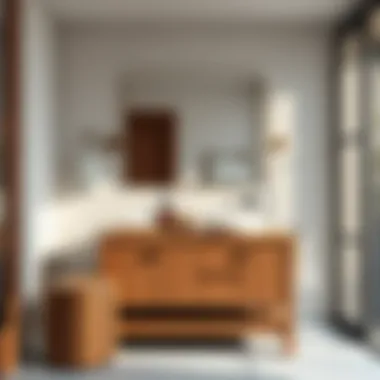
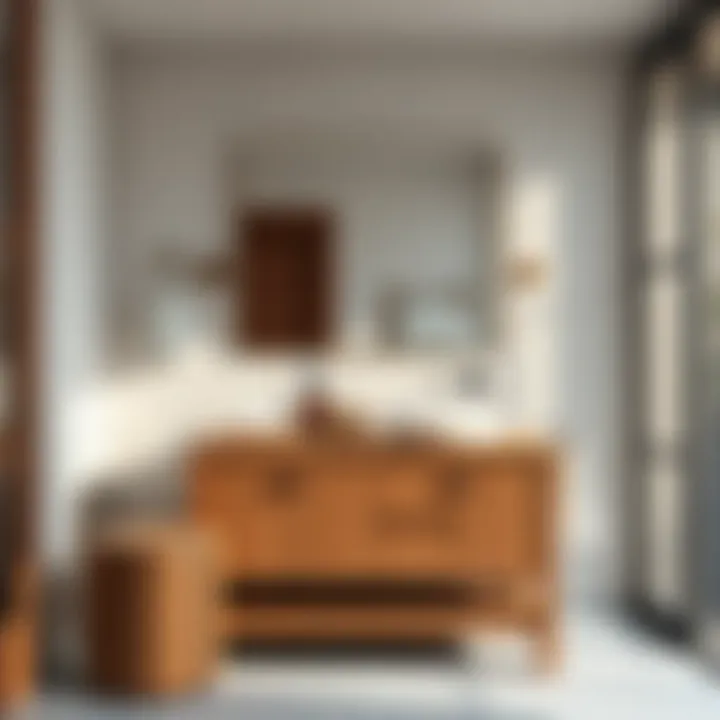
Ergonomic Considerations
Comfort in the bathroom is key to ensure that getting ready doesn’t feel like an obstacle course. Wood bath vanities, when chosen wisely, can enhance the ergonomic layout of your bathroom.
- Height Matters: The height of the vanity should suit users of different heights, especially if multiple family members share the space. A standard height of about 30 to 32 inches caters to most people.
- Flow of Movement: Consider the layout; the placement of the vanity can significantly alter how smoothly someone moves around the room. Make sure there’s enough room for multiple people to navigate even at peak hours.
- User-Friendly Access: Drawers that slide out easily and cabinets that open with minimal effort eliminate the strain when gathering items, thus reducing potential frustration.
When you think about it, a well-placed and designed vanity can contribute significantly to an enjoyable routine and create a pleasant flow in the otherwise often hectic morning rituals.
Hygiene and Maintenance
Hygiene is crucial in a space where cleanliness is expected. Thus, selecting a wood vanity shouldn’t come at the cost of easy maintenance. Utilizing the right materials and finishes not only keeps the vanity looking sharp but also makes cleanup a breeze.
- Water Resistance: Look for wood that has been treated or sealed. This protects against moisture, which is rampant in bathroom environments, helping to avoid warping and deterioration over time.
- Easy-to-Clean Surfaces: Choose finishes that are easy to wipe down. Glossy surfaces, for example, can often be cleaned easily with just a damp cloth, while those with intricate designs may require more attention.
- Routine Maintenance: Regularly inspect your vanity for any signs of wear or damage. A simple schedule to check seals and surfaces can help keep your vanity in top shape for years.
In the long run, a well-maintained wood vanity not only upholds hygiene but also enhances the overall longevity and appearance of your bathroom design.
The right balance of function and design in wood bath vanities can significantly elevate the bathroom experience, making it both a practical and beautiful space.
Choosing the Right Style
Selecting the right style is at the heart of designing a bathroom, especially when considering wood bath vanities. The style not only reflects personal taste but also integrates with the overall aesthetic of the home. When it comes to wood vanities, they bring a touch of warmth and sophistication to the space. Choosing the correct style can enhance functionality, set the mood, and even influence how the light plays across surfaces. Here, we'll explore three prominent categories—modern, rustic, and transitional designs—each with unique characteristics and benefits that cater to different tastes and requirements.
Modern vs. Rustic
When comparing modern and rustic styles, the contrast is like day and night, yet each has its own charm. Modern wood bath vanities feature clean lines and minimalistic designs that resonate with the contemporary aesthetic. They often embrace lighter wood finishes or even dark palettes, which provide a sleek contrast against white walls or tiles. Think of a maple or birch with a polished, satin finish, which can elevate the overall look of the bathroom into a chic haven of tranquility.
On the flip side, rustic designs lean towards a more natural and earthy vibe. These vanities often boast rough-hewn edges and finishes that showcase the wood’s imperfections. Reclaimed barn wood or distressed finishes are common, creating a cozy, inviting atmosphere that feels reminiscent of a cabin retreat.
Both styles have distinct appeals: a modern vanity tends to attract those who appreciate a streamlined, urban look, whereas a rustic option fulfills the desires of those yearning for comfort and warmth. Therefore, homeowners should consider what feeling they want to evoke in their spaces.
Minimalist Approaches
Minimalism in bathroom design advocates for simplicity without sacrificing style. A minimalist vanity typically features functional designs with open shelves and streamlined cabinetry. It’s about focusing on the essentials while eliminating excess. For instance, a wood vanity with integrated basins can save both space and clutter, giving that tranquil, zen-like experience everyone aspires to in a bathroom.
This approach not only promotes a sense of calm but also helps in optimizing space, which is crucial in smaller bathrooms. With fewer elements, the eyes can rest upon minimal decorations like a small potted plant or candle, allowing the natural beauty of the wood to shine through. Homeowners often find that minimalism translates to easier cleaning and maintenance, making it an appealing choice for busy families.
Transitional Designs
Transitional style is like the best of both worlds, merging modern and traditional elements. A transitional wood vanity blends the sleek lines of modern design with the warmth of classic elements. Think of a shaker-style cabinet with contemporary finishes or a blend of materials like wood and glass. This style provides versatility; it can adapt to various aesthetic preferences without feeling out of place.
In designing a transitional bathroom, you might see a refined walnut-finished vanity paired with a striking marble countertop. This creates visual interest while still being cohesive. The beauty of transitional designs is their adaptability—they can suit a broad range of design themes, from contemporary to traditional, allowing for easy updates as trends evolve.
"Choosing the right style isn’t merely about aesthetics; it’s an expression of who you are and how you wish to experience your space."
Ultimately, when embarking on the journey to select the right wood bath vanity, understanding these design philosophies—modern, rustic, minimalism, and transitional—can aid homeowners in making informed decisions that align with their tastes and lifestyles.
Space Optimization with Vanities
When it comes to bathroom design, every square inch counts. In a world where homes often come with limited space, space optimization with vanities becomes a crucial aspect of creating a comfortable and functional bathroom. A thoughtfully selected vanity can transform a cramped washroom into an oasis of organization and style. It’s about finding the right balance between utility and aesthetics, ensuring that your bathroom doesn’t just serve a purpose but also feels welcoming.
Maximizing Small Bathrooms
In smaller bathrooms, vanities with clever storage solutions can help declutter and streamline the space. A floating vanity, for instance, can create an illusion of more floor space while providing integrated shelving or drawers for essentials. It’s like a little magic trick for your bath! Here are a few pointers:
- Choose compact designs: Opt for vanities that fit neatly into the corners or that have rounded edges. This helps avoid making the space feel cramped.
- Utilize vertical space: Tall vanities with open shelves above can draw the eye upward, giving the space an airier feel while making good use of every inch.
- Mirror placement matters: A well-placed mirror can reflect light and create a sense of depth. Consider vanities with mirrored fronts or integrated lighting.
Incorporating Multiple Vanities
In larger bathrooms or shared spaces, incorporating multiple vanities can be a game changer. If two people are getting ready at the same time, having ample counter space is invaluable. It’s like getting a backstage pass to your own concert! Here are some considerations when adding more than one vanity:
- Different heights for different users: Consider installing vanities at varying heights to cater to different household members, allowing for comfort when reaching for items.
- Symmetry vs. Asymmetry: Decide if your design calls for perfectly mirrored vanities for a symmetrical appearance or if you prefer an eclectic look with varying styles and finishes.
- Sufficient lighting: Ensure each vanity has its own dedicated lighting fixtures. This will enhance functionality and create a pleasing atmosphere.
Adjustable and Modular Solutions
One of the best aspects of modern vanities is the advent of adjustable and modular options. These designs can expand or contract based on your needs, making them perfect for evolving lifestyles. They’re like the Swiss Army knives of the bathroom world.
- Expandable vanities: Some designs allow you to add or remove sections based on available space or personal preference. For instance, a two-tier vanity can provide space for sinks and additional counter areas, perfect for hosting gatherings.
- Modular components: Look for vanities with detachable units that let you customize your setup. You can choose to add drawers, shelves, or even a towel rack where it fits best.
- Flexibility: This allows users to reconfigure their space as necessary, making it ideal for growing families or those who plan to move often.
In summary, when considering how to optimize space with vanities in your bathroom, prioritize designs that enhance both functionality and style.
"A well-placed vanity is not just furniture; it’s the cornerstone of a seamless bathroom experience."


By paying attention to the nuances of space, you can create a bathroom that is both efficient and tailored to your needs. For further guidance on modern vanity options, explore resources such as Wikipedia and Britannica.
Sustainability in Design
As the conversation around environmental responsibility continues to grow, sustainability has become a pillar in modern design, especially within our homes. Integrating sustainable practices into the selection and design of wood bath vanities not only speaks to our commitment to the environment but also contributes to creating healthier living spaces. It involves making informed choices about materials, finishes, and the lifecycle impacts of our products.
When considering wood bath vanities, sustainability isn't just a trend; it's a necessity. Consumers now seek to balance aesthetics with eco-friendliness, understanding that their choices can have far-reaching consequences. From conserving forests to promoting healthier indoor air quality, there are several ways that sustainability can come alive within bathroom designs.
Sourcing Responsible Materials
The core of sustainable design starts with the materials we choose. Sourcing responsible materials includes looking for wood that is either reclaimed, salvaged, or certified by recognized environmental standards such as the Forest Stewardship Council (FSC). Each of these options makes a positive contribution to the environment.
- Reclaimed Wood: This material is sourced from old buildings, furniture, or other structures destined for the dump. It not only reduces waste but also gives unique character and history to a vanity piece.
- FSC-Certified Wood: Choosing wood that comes from sustainably managed forests ensures that the forest ecosystems remain intact and that the wood is harvested responsibly, minimizing environmental degradation.
- Bamboo: Although technically a grass, bamboo grows rapidly and can regenerate quickly, making it a likable alternative for those who seek an eco-friendly option that lends a modern twist to bathroom design.
The importance of ensuring that the wood being used is ethically sourced cannot be overstated. Not only does this practice protect the environment, but it can also enhance the value of your home, as buyers increasingly favor properties with sustainable features.
Eco-friendly Finishing Options
Once the right materials are sourced, the next phase is to consider the finishing options that can enhance the aesthetic appeal while remaining eco-conscious. Traditional finishing techniques often involve volatile organic compounds (VOCs), which can harm indoor air quality and increase health risks. On the flip side, there are several eco-friendly options available:
- Water-based Finishes: These are less toxic than oil-based finishes and typically emit fewer pollutants. They offer a streamlined application process while being kind to the environment.
- Natural Oils and Waxes: Products like tung oil, linseed oil, and beeswax provide natural protection yet bring out the wood's depths. They are biodegradable and non-toxic, making them ideal for family bathrooms.
- Eco-Friendly Paints: Low-VOC and no-VOC paints are available and have come a long way in quality and performance. They allow for a full range of color options without compromising indoor air safety.
Given the array of products on the market, selecting finishes that prioritize both appearance and ecological integrity is paramount. This not only supports the environment but also provides a healthier space for families to thrive.
"Choosing sustainable materials is not just about making a purchase; it’s about fostering an attitude towards responsible living and consumption."
To sum it up, when it comes to creating wood bath vanities, the focus on sustainability shapes the future of home design. Thoughtful material sourcing and eco-friendly finishing practices align with a growing consciousness towards the environment, paving the way for stylish yet responsible choices in modern bathroom spaces.
Installation Insights
When it comes to modern wood bath vanities, the installation phase is equally pivotal as the design and selection processes. The right installation can enhance not just the functionality of the vanity, but also the aesthetics of the room. Improper installation, however, can lead to a host of problems such as misalignment, leaks, and premature wear and tear. Thus, having insights into the installation aspect ensures that homeowners have a clear direction on how to proceed, whether to roll up their sleeves or call in the pros.
Professional vs. DIY Installation
Choosing between professional installation and Do-It-Yourself (DIY) can be a real head-scratcher for many homeowners. Both options have their upsides and downsides. On one hand, hiring a professional guarantees a level of expertise that can save time and stress; they know the ropes and their experience helps in navigating unforeseen complications. For instance, if you have uneven flooring or need plumbing adjustments, a professional would handle those concerns deftly.
On the other hand, opting for a DIY installation can be rewarding. With many instructional videos available online and detailed manuals, the process can often be straightforward if you're handy. This route also provides a sense of achievement, not to mention it’s easier on the wallet. Yet, if you're not sure about certain plumbing aspects or the weight of your chosen vanity, it's worth pondering whether you might be better off with professional assistance.
Essential Tools and Materials
Whether opting for a DIY project or preparing for professional installation, understanding essential tools and materials is crucial. Here are some of the key items you should consider:
- Level: Ensures your vanity sits evenly, which is key for functionality.
- Screwdriver Set: You’ll need both Phillips and flat-head for different fixtures.
- Drill and Drill Bits: Perfect for placing screws and mounting hardware.
- Tape Measure: Absolutely essential for taking precise measurements.
- Plumber's Putty: Helps seal joints and ensure no leaks in plumbing connections.
- Silicone Caulk: Used to seal gaps, especially between the wall and vanity.
These tools form the backbone of a smooth installation process and having them handy is a smart move.
Common Installation Challenges
Many homeowners might find themselves facing common installation challenges that can turn a straightforward task into a head-scratcher. Here are a few common issues:
- Uneven Floors: If your bathroom floor isn’t level, adjustments will be necessary to ensure the vanity sits correctly without rocking.
- Complicated Plumbing: Older homes often have unexpected plumbing configurations, making it difficult to hook up new fixtures.
- Weight Issues: Wood vanities can be heavy, requiring sturdy mounting to prevent sagging or damage.
- Wrong Measurements: A slight miscalculation can lead to a vanity that doesn’t fit or align with other elements in the bathroom.
Each of these challenges can derail an installation, so it’s wise to prepare accordingly and consider bolstering your skills through tutorials or expert advice.
"Preparation is the key to success; the better you prepare, the smoother the installation will go."
In sum, installation is a crucial step in making sure your beautiful modern wood bath vanity holds its own in both design and function.
Common Mistakes to Avoid
When it comes to selecting a wooden bath vanity, it’s easy to get swept up in the excitement of renovation and forget some critical aspects to consider. By being aware of common pitfalls, homeowners can save themselves from regret and costly fixes down the line. This section explores some common mistakes that can turn a potential design triumph into a remodeling headache.
Underestimating Space Requirements
One of the most significant errors people make is underestimating the necessary space for their new vanity. Bathrooms can often be awkwardly shaped or cramped, leading homeowners to believe they can squeeze in just about any style. But there's a fine line between creative design and poor planning.
Key considerations include:
- Measuring Twice: Before making any purchase, grab that tape measure and get accurate dimensions of your bathroom space. Consider not just width and height, but also depth. You wouldn’t want a vanity that juts out too far into your walking path, creating a potential safety hazard.
- Clearance Space: Ensure there’s enough clearance for cabinet doors and drawers to open fully without obstruction. When folks overlook this, it can lead to a frustrating experience each time they reach for their toiletries.
- Visual Weight: Large vanities can dominate a smaller space, making it feel cramped. Opt for proportions that complement rather than overwhelm the room.
In essence, your chosen vanity should merge function with design without compromising the overall spatial harmony of your bathroom.
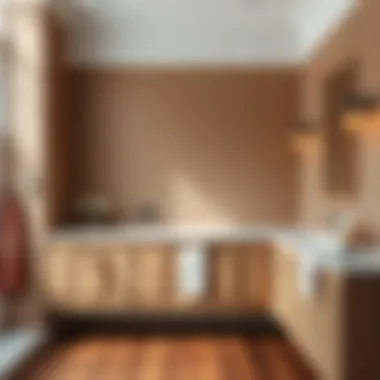
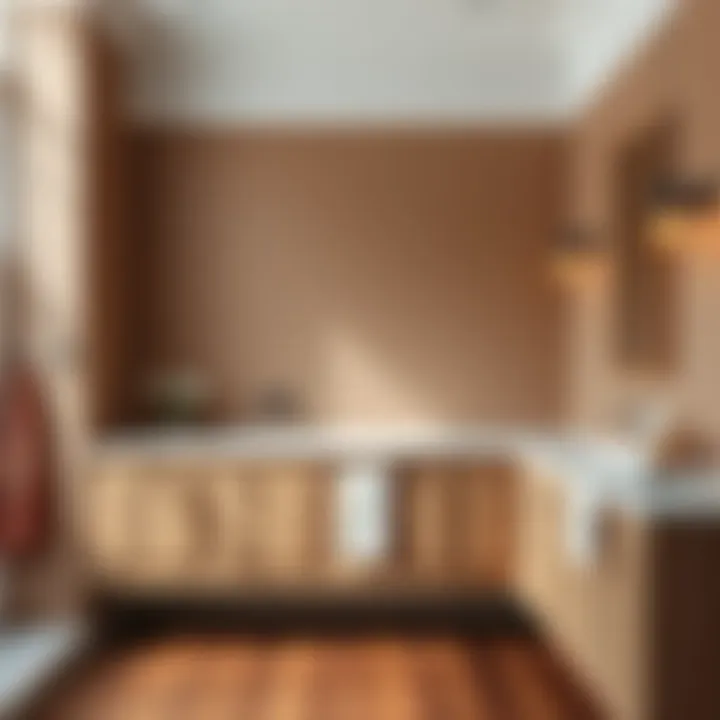
Ignoring Overall Aesthetic
Another blunder often made is misalignment between the vanity and the overall bathroom aesthetic. A stunning, modern wood vanity can easily become a visual sore thumb if it doesn’t resonate with the rest of the space.
- Style Cohesion: When incorporating a new piece into your bathroom, consider existing fixtures and decor. For example, if you have a minimalist style, selecting an ornate, rustic vanity could create an awkward clash, making the room feel disjointed.
- Color Palette: Pay attention to your color scheme. A vibrant stained wood vanity might not mesh well with a subdued, pastel palette. Color consistency across fixtures, tiles, and wall paint can create a more harmonious atmosphere.
- Theme Integration: Whether your bathroom is traditional, modern, or something in between, your vanity should align with that theme. Research design styles and take notes on what fits best. This can involve browsing through sites like Pinterest or design blogs for inspiration.
"A bathroom is not just a space; it’s a personal oasis, reflecting both functionality and aesthetic appeal."
Emerging Trends and Innovations
The landscape of modern wood bath vanities is ever-evolving, reflecting the changing tastes and needs of homeowners. Understanding the emerging trends and innovations in this space is crucial for anyone looking to make an informed choice. These trends not only enhance aesthetic appeal but they also incorporate functionality and sustainability. Through a careful examination of what’s currently on the radar, individuals can select pieces that not only resonate with their style but also offer practical advantages.
Smart Technology Integration
Like many other home design elements, wood bath vanities are now stepping into the digital age. The integration of smart technology into these fixtures is becoming increasingly popular. Imagine a vanity that includes features such as motion-sensing lights, heated countertops, or even built-in Bluetooth speakers. Not only do these additions add a dash of convenience, they also elevate the luxury feel of your bathroom space.
Homeowners can enjoy a more personalized experience with smart features. For instance, some vanities come equipped with touchless faucets, which promote better hygiene. Moreover, heated surfaces can make morning routines a bit more bearable during cold months. When considering how technology intertwines with design, it’s about making daily tasks simpler while adding to the ambiance of the bathroom.
"Smart technology is not just about luxury; it’s creating a seamless experience that integrates comfort with convenience."
However, incorporating technology into the design comes with considerations. Connectivity can often require a reliable power source, and not every home is equipped for such installations. Also, potential buyers should think about the lifespan of technology. As technology advances, older systems may need upgrades, which could incur extra costs down the line. Therefore, keeping abreast of trends in smart technology while selecting a vanity is an essential step.
Trends in Customization
Customization has taken the design world by storm, especially in the realm of bathroom vanities. Modern homeowners want pieces that speak to their unique identity. This quest for individuality drives the market toward offering tailored solutions. Whether it’s selecting specific wood grains, finishes, or designing the size and shape to fit a particular space, customization fosters a one-of-a-kind aesthetic.
- Materials: Options like reclaimed wood or sustainably sourced teak allow buyers to infuse their values into their choices.
- Finishes: Matte or gloss, natural stains or painted surfaces, the choices available are nearly limitless. Each option provides an opportunity to set a tone or theme for the bathroom.
- Sizes and Shapes: As bathrooms vary in space and layout, custom sizing becomes crucial. Choosing between a double sink or a singular feature meets both functionality and style requirements.
What's equally fascinating is how this trend ties in with eco-conscious choices. Many manufacturers are committing to sustainable practices and offering customization that reflects these values. By opting for a tailored wood vanity, one can achieve an aesthetic that aligns with personal ethos while serving practical purposes.
In summary, the merging of technology with custom solutions in bathroom vanities reshapes the modern experience. Both elements highlight a shift towards addressing personal preferences as well as promoting functionality. As this sector continues to innovate, homeowners are equipped with the tools to create spaces that genuinely reflect their lifestyles.
Budget Considerations
When it comes to choosing modern wood bath vanities, budget plays a pivotal role in the decision-making process. This topic scrutinizes how budget constraints can influence design decisions, material selections, and overall satisfaction with the final outcome. Understanding various financial aspects not only demystifies the purchasing process but also aids in making informed choices that marry aesthetics with practicality.
Cost vs. Value Analysis
One of the first steps in evaluating budget considerations is to assess the balance between cost and value. To a casual observer, this might seem like a mere tagging of price labels. However, it is crucial to realize that the price we pay isn’t solely about the monetary value. Rather, it encapsulates aspects of durability, design, and functionality.
When considering options, think first about the longevity of the materials used in the vanity. Higher upfront costs often lead to savings over time. For instance, investing in solid oak can endure wear and tear far better than cheaper particleboard alternatives. This longevity translates into less frequent replacements and thus a lower long-term total cost. Here are some elements to digest:
- Initial Cost: Be wary of excessively cheap products; they may ultimately cost you down the line.
- Maintenance: A good quality vanity may require a little more attention, but it will stand the test of time.
- Functionality: Does the vanity serve your needs efficiently? Sometimes a pricier option includes features that significantly enhance usability.
As the saying goes, "you get what you pay for," and in today’s market, that couldn’t be truer. A careful examination of how much one is willing to spend can offer clarity on how much value they are going to receive in return.
Finding Quality on a Budget
Quality doesn’t always equate to a heavy price tag, and it’s entirely possible to scoop up excellent options without breaking the bank. Here are some strategies that might help you navigate this terrain:
- Research: Prioritize reading customer reviews and expert opinions. Websites like Reddit often have threads discussing the best budget-friendly vanities.
- Sales and Discounts: Keep an eagle eye out for seasonal sales. Many high-end stores often mark down their inventory to make way for newer models.
- Alternative Suppliers: Consider smaller retailers and online marketplaces where high-quality products are often available at lower prices.
- DIY Options: If you’re feeling crafty, buying a base model and applying a personal touch can both cut costs and provide a unique look. A bit of paint and new hardware can work wonders.
Ultimately, utilizing these approaches ensures that the quest for quality remains viable even for those on a tight budget. The right wood bath vanity can substantially enhance bathroom spaces without emptying the wallet, making it possible to achieve both functionality and style.
"The trick is not to spend money when you don’t have to. Knowing where to look, how to evaluate worth, helps in achieving a satisfactory purchase."
End and Final Thoughts
In navigating the intricate landscape of modern wood bath vanities, it's crucial to understand that the choices made extend beyond mere functionality; they speak volumes about personal style and lifestyle needs. This article has journeyed through a myriad of facets surrounding these focal points in bathroom design, underscoring their significant role in creating a harmonious and practical space. A thoughtfully selected wood vanity can serve as a centerpiece that combines aesthetics and utility, thereby enhancing the overall experience of the bathroom.
Key elements highlighted throughout our exploration include the importance of material characteristics, which not only determine the vanity's durability but also its visual appeal. Understanding these aspects enables homeowners to make better informed choices that genuinely reflect their taste. Furthermore, we touched upon aesthetics, sustainability, and practical considerations such as installation and maintenance. Each of these factors intertwines, contributing to a sophisticated yet functional space that meets modern demands.
As the world of interior design continues to evolve, it’s evident that the integration of innovative trends and responsible sourcing will define the future of wood bath vanities. The key is to maintain a balance between what looks good and what works well. A bathroom equipped with the right vanity can transform the mundane routine of daily rituals into a luxurious experience. The blend of wood's natural warmth with modern functionality encapsulates a design that feels both inviting and practical, meeting the needs of today's homeowners.
"A meticulous approach to vanity selection not only enhances the bathroom's appeal but also elevates one’s daily interactions with the space."
Thus, thoughtful consideration of these elements means not just endowing your bathroom with a utility fixture, but investing in a statement piece that fortifies the essence of your home.
Recap of Key Points
- Material Characteristics: Selecting the right wood is paramount to ensure longevity and alignment with personal aesthetic preferences.
- Aesthetic Appeal: A well-chosen vanity integrates seamlessly with existing decor while offering visual interest.
- Functionality: The right vanity encompasses essential design functionalities such as storage and ergonomics.
- Sustainability: Modern homeowners are increasingly prioritizing eco-friendly options in their selections.
- Installation: Choices between professional and DIY can significantly affect both outcome and convenience.
- Common Mistakes to Avoid: Familiarity with prevalent pitfalls can assist homeowners in making wiser choices.
- Emerging Trends: Keeping up with innovations allows for dynamic customization and smart technology adaptation.
- Budget Considerations: Analyzing costs versus values ensures that homeowners invest wisely and sustainably.
Encouraging Thoughtful Selection
When it comes to choosing a bath vanity, the process should mirror a personal journey rather than a mere transactional experience. Take the time to ponder over individual needs and preferences, as these will significantly shape your selection. Here are a few guidelines:
- Assess Your Space: Know your bathroom's layout and dimensions. Measure carefully to avoid the awkwardness of a clunky, oversized vanity.
- Define Your Style: Think about the mood and style of your bathroom. Do you prefer a sleek minimalist look, or something more rustic and traditional?
- Evaluate Functionality: Reflect on how you'd like to use the space. Will you need ample storage, or does simplicity reign?
- Research Materials: Consider the characteristics of different woods and finishes. Not all woods are created equal; some are more resilient to moisture and wear.
- Stay Updated: Keep an eye on trends but always filter them through your personal lens. What may be trending might not suit your lifestyle.
- Get Opinions: Don’t hesitate to seek insights from friends or experts who have walked a similar path. Their experiences can be invaluable.
By thoughtfully navigating through these steps, you set yourself up for success in choosing a wood bath vanity that resonates with your taste while serving practical needs. This is not just about aesthetics; it’s crafting a sanctuary that feels uniquely you, enhancing the joy of your everyday routines.



